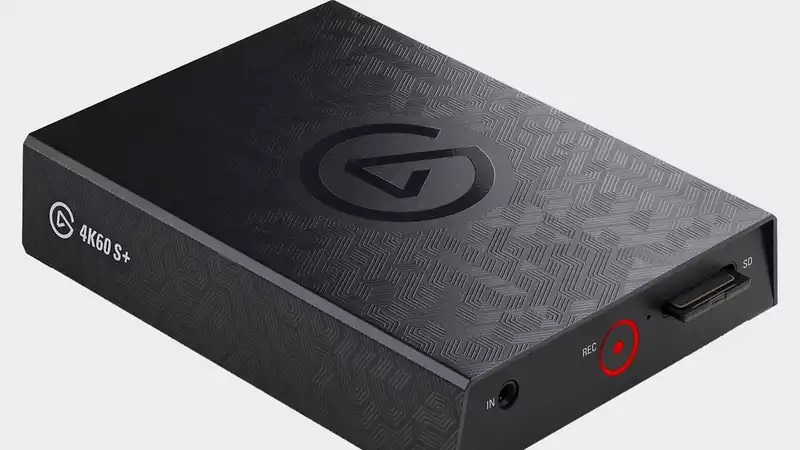Elgato has been the standard bearer for everything related to game capture cards and streaming in general, and the HD60S+ is a perfect example of this, having been part of the inventory of the most serious streamers for years due to its ease of use and price. With the release of the 4K60 S+, however, Elgato is looking to the future. By future, I mean the next generation of 4K capable gaming consoles with HDR support will be released.
The Elgato Game Capture 4K60 S+ is for content creators looking for a significant channel upgrade. First, it can capture 4K HDR gameplay directly to PC or SD card. This is a big plus for console gaming and a long-awaited feature for veteran Elgato users. 4K60 Pro is similar in terms of what it can capture, but the S+'s superior portability is what you'll be interested in.
One super convenient aspect of stand-alone recording is that the 4K60 S+ optimizes itself in real time. The recording process itself becomes relatively simple since you don't have to worry about adjusting settings before recording. Anyone who has ever tried to capture footage at a trade show or preview will know how much of a nightmare it can be to shoot on the fly. With the new Elgato 4K60S+, however, all you have to do is connect the device to power (via USB-C), HDMI in/out, insert a 256GB SD card (compatible with V30 or UHS-3 SD cards), press the record button, and you are ready to rock.
First, I recorded 4K footage of Final Fantasy 7 Remake on the PS4 Pro. The zero-latency pass-through allowed me to be Cloud and beat up Shinra's minions. I then hopped on the Xbox One's Apex Legends target range. This time I changed the display settings on the Xbox One X to 1080p, but the 4K60 S+ made the change automatically without issue.
The video looked great and it was easy to extract clips from the SD card via the card reader. Frankly, I had more problems managing the video files using the Elgato 4K Capture Utility software. This software is the only place to make changes to the capture card and adjust image settings.
The real problem is that this software is not as robust as the HD capture software for Elgato's other cards: the 4K60 S+ will not work with HD capture software, forcing the use of the 4K Capture Utility, which The utility does not allow video editing and only supports raw capture and commentary tracks. If you want to do anything significant with these clips, you will need to invest in third-party editing software.
Then you have to figure out how to handle the captured high dynamic range video. Even professional video editors have trouble handling HDR footage. Thankfully, Elgato has provided some useful guides for handling HDR video. It also wouldn't hurt to have an HDR-capable monitor. If not, the 4K capture utility will try to use Tonemapping to get a close approximation to the original. In this case, however, the image may appear flat and desaturated.
Streamers will likely not care about streaming at 4K and 60Hz. Bandwidth issues aside, the 4K60 S+ is a good card for streaming; the lack of Instant Gameview (which other Elgato capture cards have) is a major disappointment. Instant Gameview is basically a nearly latency-free preview of gameplay, which is useful when you only have one monitor; according to Elgato, my latency seems to be around 200ms, but they say it could be 250ms or more. Thankfully, OBS and Xspit have settings to create delays on the microphone and webcam to match gameplay.
To be honest, I find it a bit odd that the barrier to entry is so high for Corsair's first foray into standalone recording after its acquisition of Elgato. If you're a content creator who doesn't care about 4K (and only works with 1080p footage), you can get the AverMedia Live Gamer Portable 2 Plus, which has all the features for less than half the price of this capture card. Personally, I think it is a missed opportunity that the Elgato HD60 S+, which supports standalone recording, is not yet available.
However, it is the only external capture card on the market that can capture 4K60 and HDR footage, so you can record really great footage to play and share. Standalone recording is an attractive proposition, but the 4K60 S+ is priced out of competition for most content creators.
To really take full advantage of this capture card, you'll need a 4K-capable console, an HDR-capable 4K monitor (not cheap), and a PC robust enough to edit 4K HDR footage (not really cheap) The amount of bandwidth required to upload, let alone stream, 4K footage Let's not even mention the following.
The Elgato 4K60 S+ is the capture card of the future. If you have hardware that can handle high quality media, you can take the best looking screenshots and videos. Still, the capture market has yet to catch up to the fidelity that the 4K60 S+ can deliver.
.

Comments